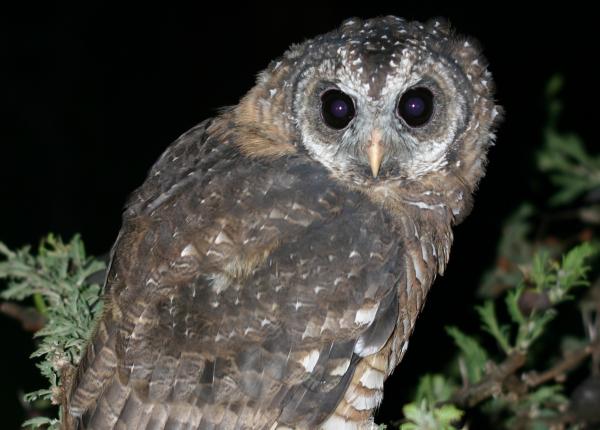Did You Know?
- There are four recognized subspecies of the African Wood-owl
- In all of Africa, there is only one owl species from the genus Strix. It is the African Wood-owl, of course.
How The Peregrine Fund is Helping
The Peregrine Fund is not working directly with African Wood-owls, but our conservation efforts through habitat protection, education, and community outreach extend to all raptor species, including this owl. We also supply literature to researchers from our avian research library, which helps scientists around the world gather and share important information on raptor conservation.
Where They Live
Living up to its name, the African Wood-owl is found throughout a large portion of sub-Saharan Africa. They are quite adaptable to living in a number of different habitats including dense forests, sparser woodlands, forests along coastlines, riparian areas, and they are even found in agricultural plantations.
What They Do
Like many owl species, the African Wood-owl is mostly nocturnal. Like many other owls, and even some forest-dwelling eagles, such as the Harpy Eagle, the African Wood-owl uses its powerful eyesight and keen hearing to catch prey at night. To help them hear even better, these birds are equipped with facial discs. The facial disc is composed of feathers that form a circle around the bird’s face. The disc can be lifted or lowered at will. When the feathers of the facial disc are raised, they help direct sounds to the birds’ ears, which are located on the sides of its head. To find out how this works, cup your hands behind your ears and listen. You might notice that whatever you are listening to seems louder.
This lovely owl does not migrate.
Why They Need Our Help
The African Wood-owl is classified as Least Concern. This owl seems to be common in its range and, thankfully, isn't facing any serious threats to its survival, as far as we know. Much of their habitat is in protected areas, which is great news, but that doesn't mean that some habitat loss isn't occurring in their range. Some individuals have also drowned in reservoirs, and because they spend some time hunting along roads at night, it is possible that some are killed in vehicle collisions as well.
What They Eat
The African Wood-owl is not a picky eater. It feeds on many different types and sizes of prey. While it does seem to mostly hunt insects, such as grasshoppers, cockroaches, praying mantis, moths, and caterpillars, it will also feed on different types of mammals - mainly rodents, as well as reptiles, frogs and even passerines and other birds.
The owl employs a few hunting strategies to catch its prey. It may sit on a low perch, watching and waiting, until it sees something tasty pass by. When it does, it will drop down onto it and snatch it up. It sometimes chases insects on the wing, or picks them from leaves or other vegetation.
Nests, Eggs, and Young
Like most owl species, these owls nest in natural cavities, such as holes in trees. They will also sometimes nest directly on the ground at the base of a tree, or under a log, or sometimes even more out in the open. There are have been a couple of reports of these owl using an old stick nest build by another raptor.
The female will lay 1–3 eggs, which she will incubate for around 31 days. While she is tending to the eggs, the male will work hard to find enough food for himself and for the female. When the owlets hatch they are covered in fluffy white down. For the nest 3 weeks of their lives, the female will stick close to the nest and will brood her young to make sure they are safe and warm enough. Once the owlets are older than 3 weeks, both the male and female will hunt and bring prey back for their young. After a month or so, the young owls will be ready to branch out from the nest for the first time. At this point, they might leave the nest cavity and wander around the tree branches, while they gain strength. When they are around 46 days of age they will be ready to fly for the first time. However, even though they can fly, that doesn't mean they are ready to survive on their own. They will remain with their parents for around 4 more months learning to hunt and to avoid danger.
Some young owls are reluctant to leave their parents' territory. If they are still around when the next breeding season starts, the parents will kick the owls out of their territory.
African Wood-owl and The World Center for Birds of Prey
Though far from African Wood-owl territory, the World Center for Birds of Prey offers fun ways to learn about birds of prey. Interactive activities, tours, interesting videos and a children's room with activities from coloring sheets to quizzes to costumes await you. At our visitor center, you can see live owls up close, including an Eastern and Western Screech-owls, a Verreaux's Eagle-owl, and an Eurasian Eagle-owl. Come learn about the wonderful and interesting adaptations they have in order to survive in their respective habitats. There is also a touch table with owl feathers and other natural objects available for exploration.
References:
Holt, D. W., R. Berkley, C. Deppe, P. L. Enríquez, J. L. Petersen, J. L. Rangel Salazar, K. P. Segars, K. L. Wood, J. S. Marks, and P. F. D. Boesman (2020). African Wood-Owl (Strix woodfordii), version 1.1. In Birds of the World (T. S. Schulenberg, Editor). Cornell Lab of Ornithology, Ithaca, NY, USA. https://doi.org/10.2173/bow.afwowl1.01.1










